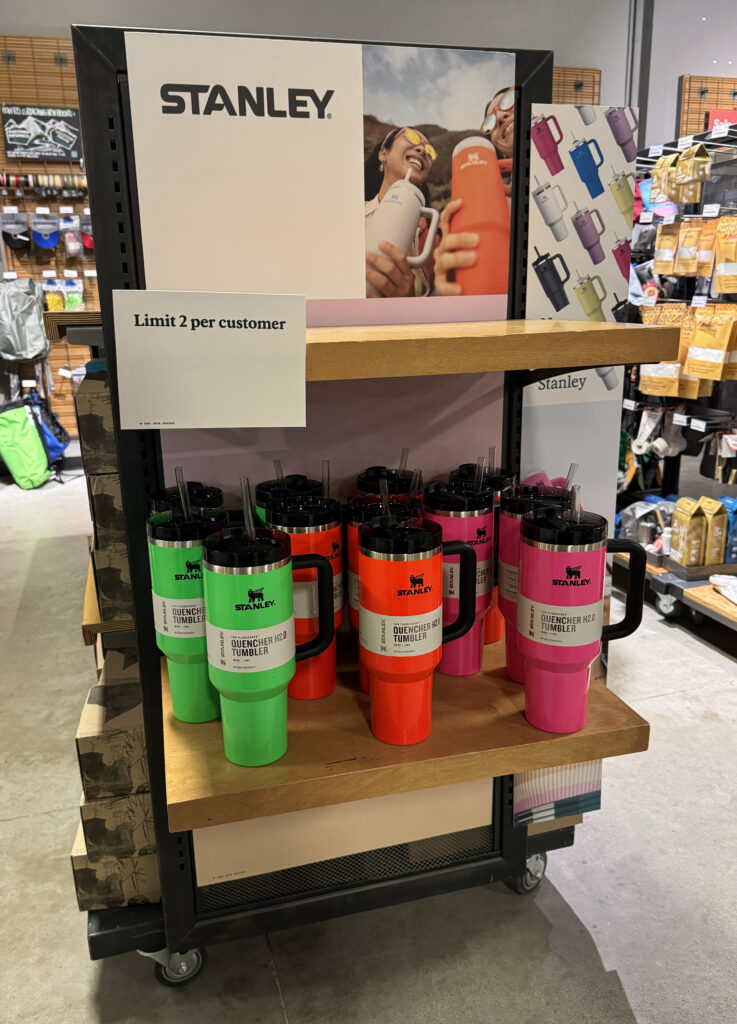By Kristan Reynolds, The Invading Sea
Replacing single-use plastic water bottles with a reusable water bottle can reduce plastic waste while maintaining convenience — but reusable bottles can create their own waste when purchased and thrown away at high rates.
Reusable water bottles, such as those made by the Stanley brand, have increased in popularity due to viral videos on TikTok and other social media platforms. But this has also led to the overconsumption and mass disposal of these items, which creates significant environmental harm and waste, said Jacqueline Salmond, a sustainability researcher in Fort Myers.
“Stanley cups are interesting because part of their promotion is that they’ll last for a long time — which they do, which is fantastic — but that would tell you that you don’t need to have 50 of them, or even five of them,” Salmond said. “You need one, maybe two tops.”
Katlyn Griffin, a 26-year-old Umatilla resident, said she currently owns 32 reusable water bottles. But Griffin would advise against others doing the same.
She said that she bought her first Stanley cup a few weeks before they got big on social media, but new “bright and cute patterns” she saw on TikTok prompted her to buy more.
“Don’t buy as many of them as I have, it’s a waste of money,” Griffin said. “You don’t get to use anywhere near all of them, so it’s almost like it’s just a waste.”

Salmond says that the environmental harm caused by the overconsumption of reusable water bottles, specifically Stanley cups, mainly comes from the production, shipment and disposal of the bottles.
“It’ll stop producing the plastic, so ultimately, great,” said Salmond about the popularity of reusable water bottles over disposable ones. “But if we just used huge amounts of steel to produce these things that are then just going to be gathering dust in people’s homes, then it’s not actually as sustainable as we would like it to be.”
Some reusable water bottle collectors try to be conscious of their purchasing patterns in order to maintain sustainability.
“I don’t find it reasonable to buy more cups than needed,” said Staley Bretoux, 19, a Florida Atlantic University student studying neuroscience. “The amount of cups that I’ve bought, I didn’t purchase unless I had multiple reasons to use it, as it can just be a waste of money and overconsumption.”
In order to produce Stanley cups and other reusable steel water bottles, iron must be mined and then smelted into steel, Salmond said. This process damages wildlife habitats, requires significant energy and generates CO2 emissions, according to Salmond.
Salmond also says that the transportation of the bottles, as well as the packaging used to protect the items, should be included in the overall environmental cost.
“There’s not much waste when you’re actually using the item — the consumable kind of stage —but then what happens when they’re dead?” Salmond said.
According to Salmond, the steel core of the bottle itself can be recycled, but most waste in the United States is sent to landfills.
“At the point of disposal, it would just get dumped in a landfill, and then we need to mine more iron ore to make more steel and cause more impacts,” Salmond said. “This is part of the problem of these things not being part of a circular economy — so they’re not part of a sustainable economy, where they’re in a cycle — we just have a linear viewpoint.”
Salmond believes that social media has changed the patterns of consumption, prompting overconsumption.
“Previously, it would be maybe a slow burn for something to gain popularity and for something to be desirable, but now we’re fed into this sort of frenzy, where we feel that we have to have something,” Salmond said. “It puts pressure on people, because they feel that they have to have it so that they can be part of a particular movement.”
The Stanley brand as well as reusable cups made by other companies such as Hydroflask and Owala have gained popularity on TikTok and through other social media platforms.
On TikTok, some Stanley cup collectors hopped on the trend of showing off their collections to the song “Mr Pot Scraper” by the rapper BossMan Dlow. TikToker Bri Lowell showcased her collection of 50 Stanley cups with varying colors and styles and amassed 20.5 million views and 2.9 million likes.
Meanwhile, other TikTokers are already throwing away or selling their Stanley cups and replacing them with newer, trendier water bottles.
“Some people will still keep (their bottles) permanent — that’ll be fine, but in terms of it being a trend, people will switch gears to something else, and then they will overconsume that something else,” Salmond said.
Griffin plans to stick to the bottles that she currently owns and advises others to be “aware of how many they buy versus how many they can actually use at one time; At the end of the day, you’re only going to carry one of those cups with you.”
Kristan Reynolds is a Florida Atlantic University senior majoring in multimedia journalism and minoring in communication studies who is reporting for The Invading Sea during the summer 2024 semester.
Sign up for The Invading Sea newsletter by visiting here. If you are interested in submitting an opinion piece to The Invading Sea, email Editor Nathan Crabbe at ncrabbe@fau.edu.



